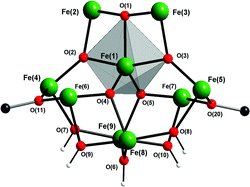Aggregation of dinuclear {Fe2hpdta} units to form polynuclear oxy/hydroxy-bridged Fe(iii) coordination complexes†
Abstract
An approach for the preparation of

* Corresponding authors
a
School of Chemistry & Centre for Research on Adaptive Nanostructures and Nanodevices (CRANN), University of Dublin, Trinity College, Dublin 2, Ireland
E-mail:
schmittw@tcd.ie
Fax: +353 1 671 2826
Tel: +353 1 896 3495
b
Institute of Inorganic Chemistry, Karlsruhe Institute of Technology, Engesserstr. 15, Karlsruhe, Germany
E-mail:
powell@kit.edu
Fax: +49 721-608-8142
An approach for the preparation of

 Please wait while we load your content...
Something went wrong. Try again?
Please wait while we load your content...
Something went wrong. Try again?
W. Schmitt, L. Zhang, C. E. Anson and A. K. Powell, Dalton Trans., 2010, 39, 10279 DOI: 10.1039/C0DT00655F
To request permission to reproduce material from this article, please go to the Copyright Clearance Center request page.
If you are an author contributing to an RSC publication, you do not need to request permission provided correct acknowledgement is given.
If you are the author of this article, you do not need to request permission to reproduce figures and diagrams provided correct acknowledgement is given. If you want to reproduce the whole article in a third-party publication (excluding your thesis/dissertation for which permission is not required) please go to the Copyright Clearance Center request page.
Read more about how to correctly acknowledge RSC content.
 Fetching data from CrossRef.
Fetching data from CrossRef.
This may take some time to load.
Loading related content
